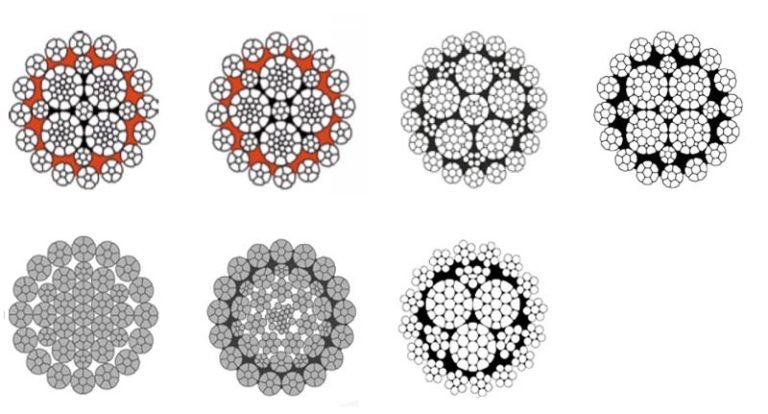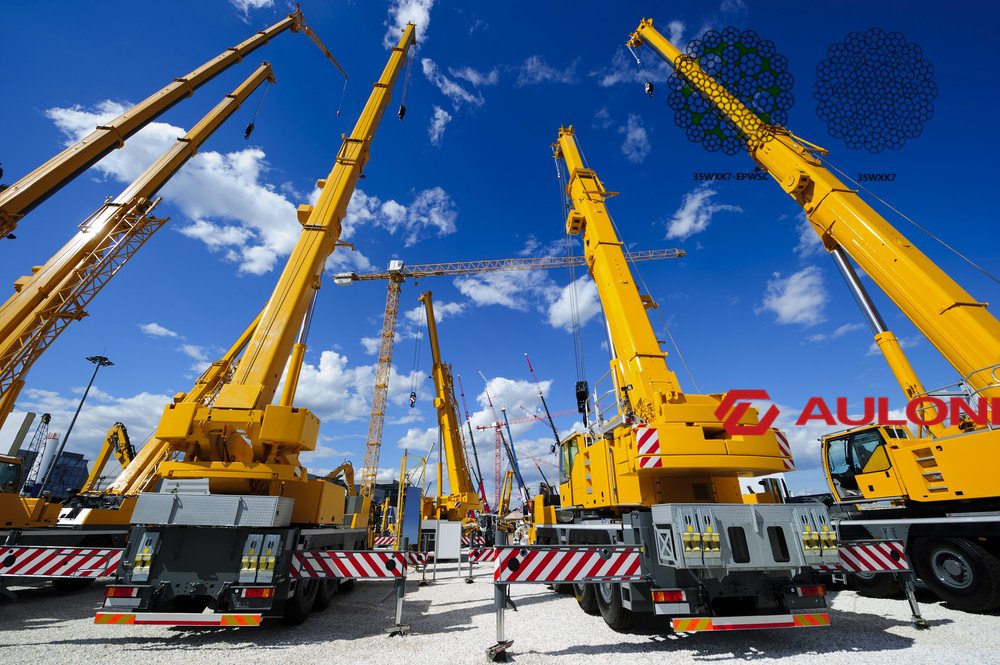Crane wire ropes used for hoisting and lifting are designed to handle the demanding environments and heavy loads associated with various crane operations. These ropes must provide high strength, flexibility, durability, and, in some cases, resistance to rotation. The selection of the appropriate wire rope depends on the crane type, load requirements, and the specific operation being performed.
Key Wire Rope Types for Hoisting & Lifting:
1. Non-Rotating Wire Rope
- 35WXK7 (35×7 Class): This is a popular non-rotating wire rope used in applications where rotation of the load is undesirable, such as high-lift tower cranes, mobile cranes, and offshore lifting. The multiple layers of wires are designed to counteract rotational forces under load, providing better load stability.
- 19×7 and 18×7 Non-Rotating Ropes: These ropes also offer excellent rotation resistance and are often used for hoisting applications. They are typically used in cranes where high lifting heights require the prevention of load spin.
2. General-Purpose Hoisting Rope
- 6×19 IWRC (Independent Wire Rope Core): A common and durable wire rope that provides excellent strength. It is typically used for hoisting and lifting applications where rotation is not a significant concern. It balances strength and abrasion resistance.
- 6×36 IWRC: This rope offers more flexibility compared to the 6×19 due to the higher number of wires. It is suitable for applications requiring frequent bending over sheaves and is often used in crane operations that don’t require rotation resistance but demand good fatigue life.
3. Plastic-Coated Wire Rope
- 8XK26WS-EPIWRC: Designed with a plastic coating for improved abrasion resistance and protection of the internal core. This rope is ideal for harsh environments where the rope is exposed to abrasive materials, moisture, or other harsh conditions, such as offshore or marine cranes.
4. High Tensile Galvanized Wire Ropes
- Galvanized Ropes: These are highly resistant to corrosion and are suitable for outdoor and marine cranes that operate in environments where exposure to water, salt, and humidity is common. Galvanization extends the rope’s life, reducing the need for frequent maintenance and replacements.
Key Considerations for Crane Wire Ropes:
- Load Capacity and Breaking Strength:
- The wire rope must have a breaking strength that exceeds the crane’s maximum lifting capacity to ensure safety and durability. It’s essential to factor in the safety margin when selecting the rope for lifting applications.
- Flexibility vs. Strength:
- Wire ropes like 6×36 IWRC offer greater flexibility, making them suitable for cranes with frequent bending or high-cycle operations. Ropes like 6×19 IWRC, on the other hand, offer higher strength and abrasion resistance, which is ideal for less flexible applications.
- Rotation-Resistance:
- For cranes that lift loads at great heights or where rotation is problematic, non-rotating ropes like the 35×7 Class are essential. They prevent the load from spinning during the lifting process, ensuring greater control and safety.
- Durability and Fatigue Resistance:
- Wire ropes used in hoisting and lifting operations undergo heavy stress and wear, so fatigue resistance is critical, especially for high-cycle applications. Ropes with a higher number of wires per strand, such as 6×36, are better suited to handle the repeated bending over sheaves.
- Corrosion Resistance:
- For environments prone to corrosion (e.g., marine or outdoor applications), selecting galvanized or plastic-coated ropes is important. These ropes resist environmental damage and prolong the lifespan of the rope, requiring less maintenance.
Inspection and Maintenance:
- Regular Inspections: It is critical to inspect crane wire ropes regularly for signs of wear, corrosion, broken wires, or deformation. Any deterioration in the rope can significantly affect safety and performance.
- Lubrication: Proper lubrication of the rope ensures smooth operation, reduces internal friction, and prevents corrosion.
- Replacement: Replace wire ropes before they reach their wear limits to ensure safe crane operation. Regularly replacing ropes also prevents unexpected failures during lifting operations.
Aulone’s Quality Assurance:
At Aulone, we specialize in producing high-quality crane wire ropes tailored to specific lifting and hoisting needs. Our ropes are manufactured with precision using advanced German technology, which increases precision by 30%. We offer customizable wire ropes that meet the highest international standards for durability, strength, and safety, ensuring optimal performance in every application.
If you’re looking for a specific wire rope solution, feel free to contact us for more details on our available products and customization options!
Ask For A Quick Quote
Fill out a quick form to get a personalized quote tailored to your specific needs.








